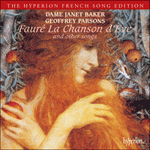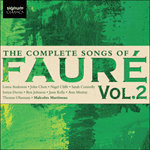In the Hugo source this poem is entitled
Nouvelle chanson sur un vieil air, suggesting that the poet fitted new words to a tune he already knew. Hugo wrote the lyric for his mistress Juliette Drouet. The poem was set by Liszt in 1844 (with an impossible piano part), by César Franck in 1847, and soon afterwards by the adolescent Saint-Saëns (on Hyperion CDA66856) as an Offenbachian
galop. Liszt’s revised version dates from 1859. Saint-Saëns’s title is
Nouvelle chanson but other composers adopt the poem’s first line —
S’il est un charmant gazon. Fauré’s setting, the celebrated poem disguised by this title, is one of the least performed of his songs. It is true that it is more four-square and strophic than his later work, and it has a certain affinity with Gounod—though it is none the worse for emulating that master’s gift for combining sensuality with pudeur. The prosody is far from perfect. But what is already typical of Fauré is the fluidity and independence of the bass line, and the delicacy of the syncopated quavers that shadow the voice and trace the ghost of a counter-melody. The composer directs that the third verse should be sung slower than the others, a modification unique in his songs.
from notes by Graham Johnson © 2005
Chez Hugo, ce poème s’intitule
Nouvelle chanson sur un vieil air, suggérant que le poète posa de nouvelles paroles sur un air qu’il connaissait déjà. Hugo écrivit ces vers pour sa maîtresse Juliette Drouet. Liszt les mit en musique en 1844 (avec une partie de piano impossible); César Franck en fit de même en 1847, suivi de peu par un Saint-Saëns adolescent (sur le disque Hyperion CDA 66856), qui en fit un galop offenbachien. La version révisée de Liszt date de 1859. Saint-Saëns baptisa sa pièce
Nouvelle chanson, titre auquel les autres compositeurs préférèrent le premier vers du poème:
S’il est un charmant gazon.
Rêve d’amour (derrière cet intitulé se cache le même fameux poème) est l’une des mélodies fauréennes les moins jouées—il est vrai qu’elle est plus tranchée et plus strophique que les oeuvres ultérieures et qu’elle offre une certaine affinité avec Gounod (même si cela ne fait pas de mal à Fauré d’imiter le don du maître pour le mélange sensualité/pudeur). La prosodie est loin d’être parfaite. Mais ce qui est déjà typique, c’est la fluidité, l’indépendance de la ligne de basse, et la délicatesse des croches syncopées qui collent à la voix et esquissent un fantôme de contre-mélodie. Fauré voulait que la troisième strophe fût chantée moins vite que les autres—une indication unique dans ses mélodies.
extrait des notes rédigées par Graham Johnson © 2005
Français: Hypérion


 Fauré: La chanson d'Ève & other songs
Fauré: La chanson d'Ève & other songs Fauré: The Complete Songs, Vol. 2
Fauré: The Complete Songs, Vol. 2
